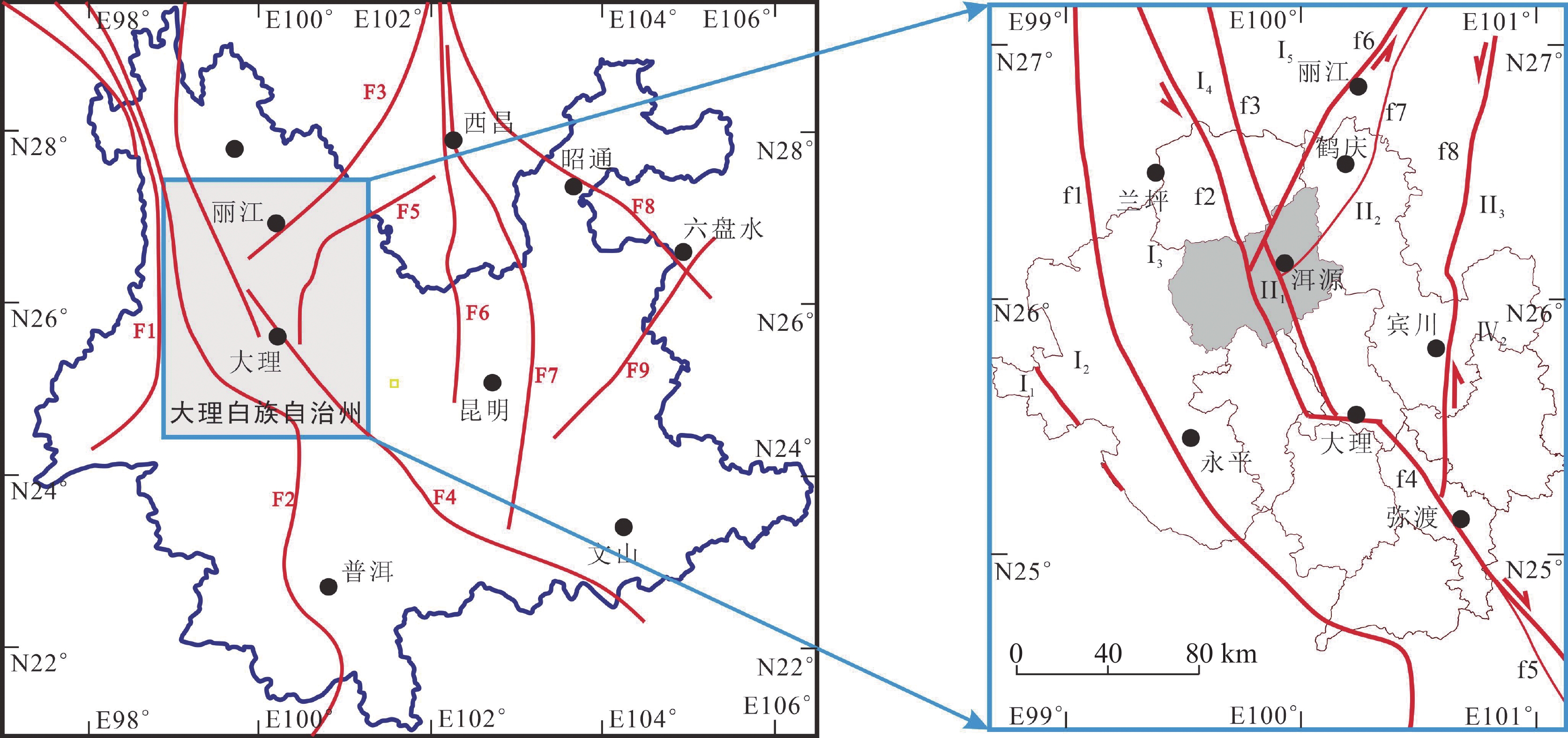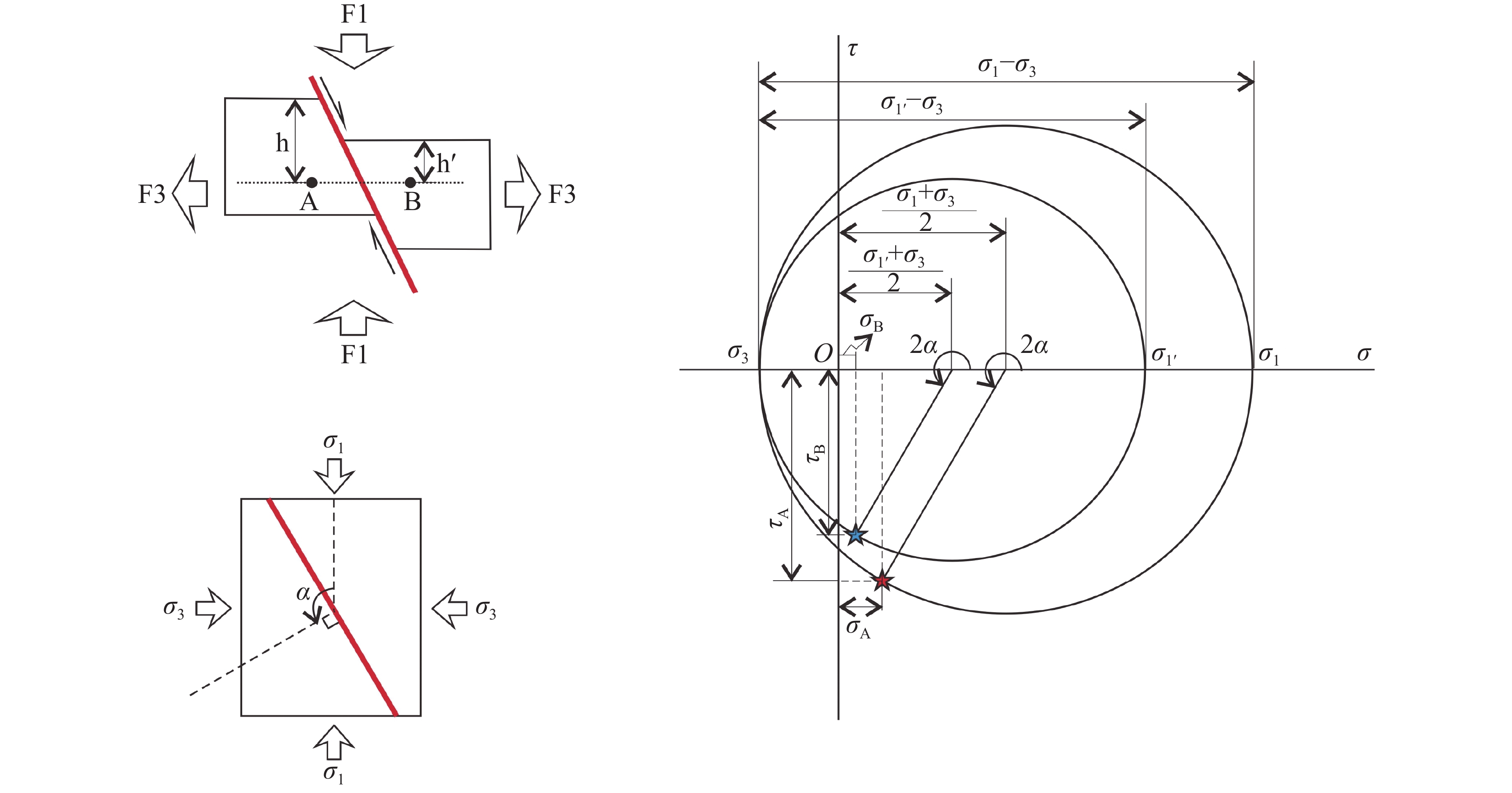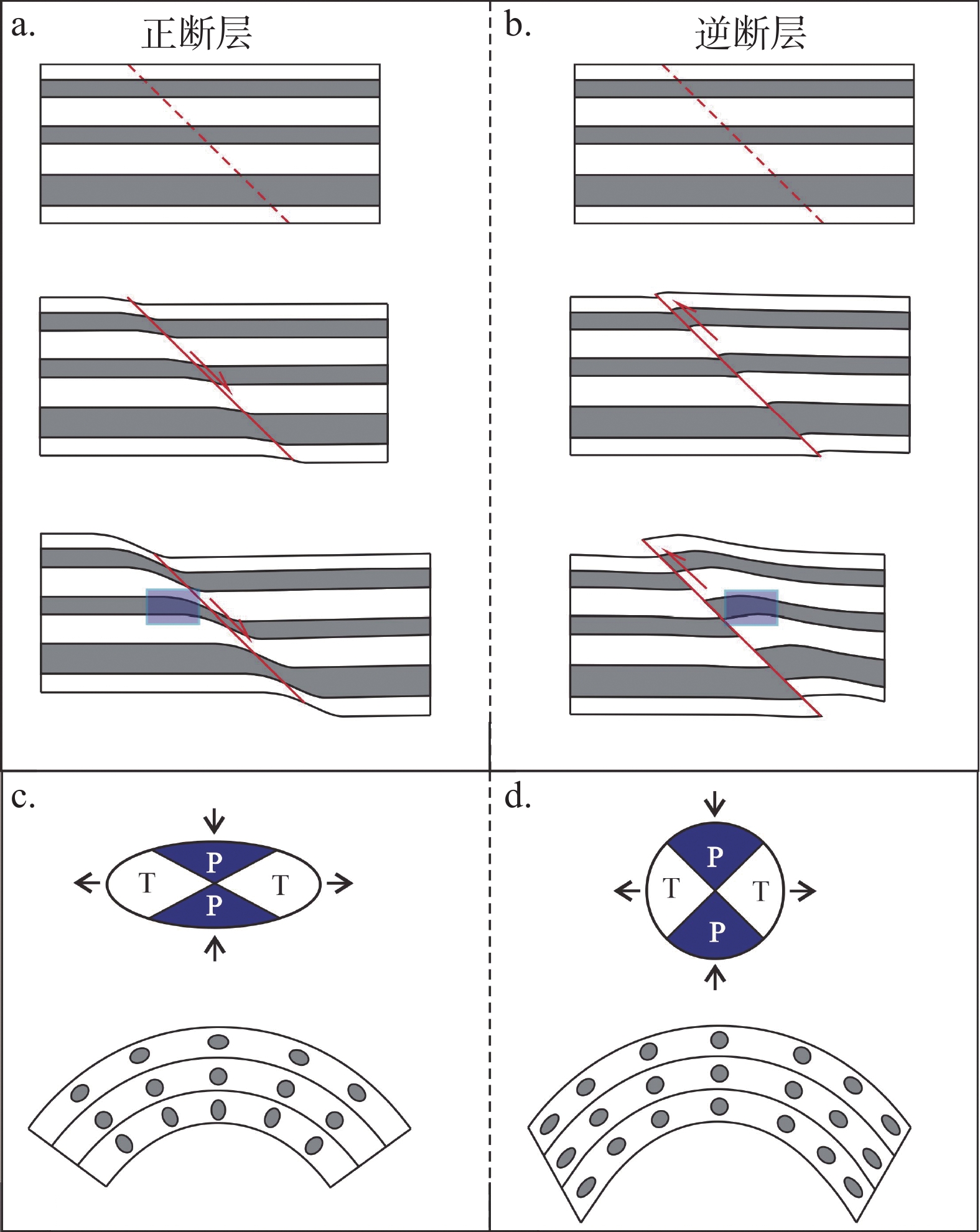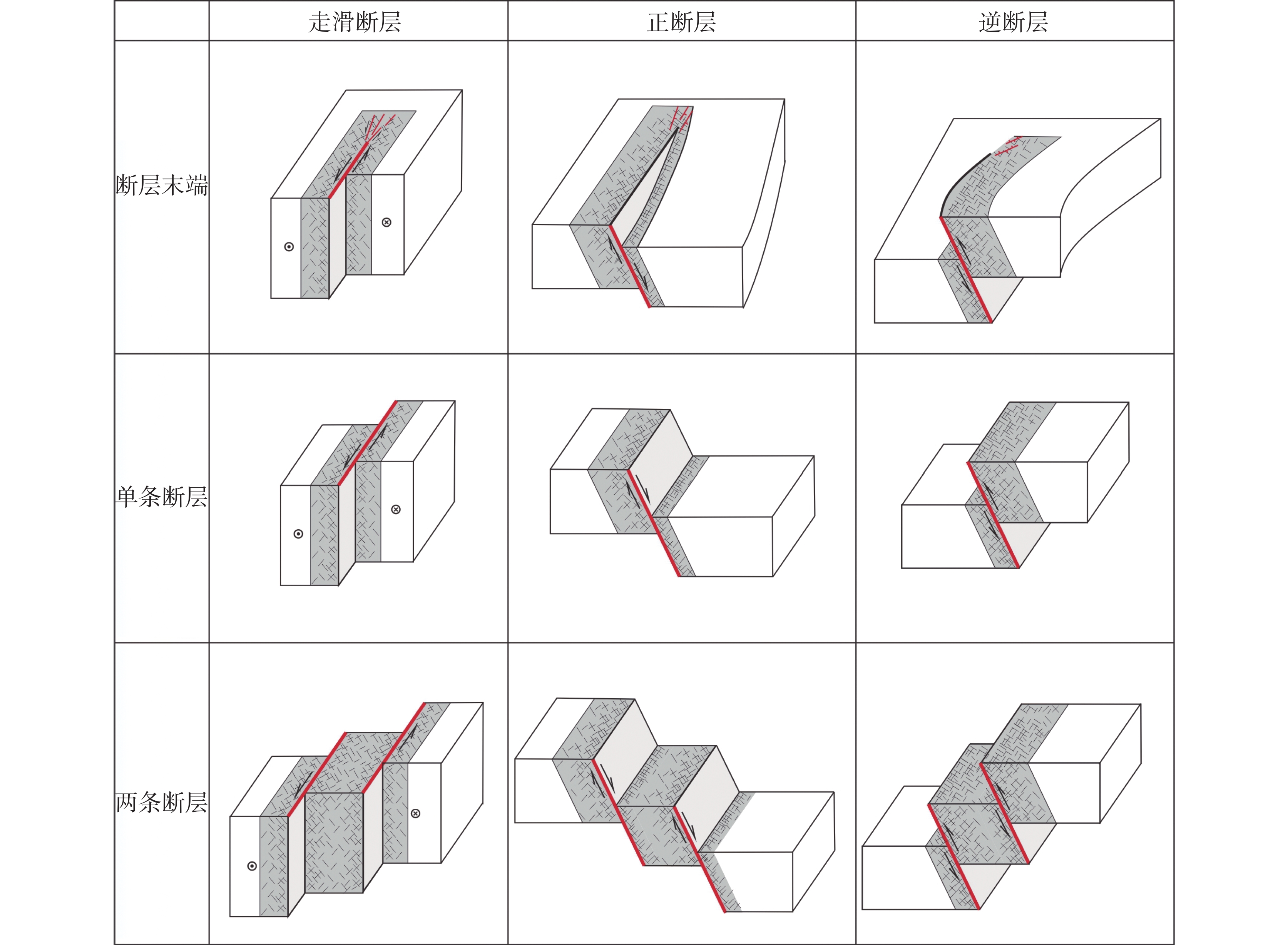Characteristics of faults and their controlling effect on geothermal energy in Eryuan county, Yunnan Province
-
摘要:
地热资源在未来的能源结构中具有重要地位,为分析云南省洱源县地热资源分布的构造控制因素,文章通过野外地质调查对县域内多条重点断裂进行了野外露头观测和分析,对不同断裂类型两盘受力情况进行计算和分析,并通过三维立体图形对县域内断裂与地热分布进行了展示,结果表明:洱源县域内发育多条大型断裂带,走向以NW—SE向为主,具有多期构造活动,具“压扭性”或“张扭性”特征,并被后期张性断层切割改造;正断层下盘及逆断层上盘具有更大的正应力值和剪应力值,多发育牵引背斜,更容易发育裂缝;断裂构造对温泉的控制作用明显,其中大型走滑断裂可沟通深部热源,温泉热水可沿后期张性断裂发生地下径流,然后可在断裂附近的裂缝发育带、断裂交汇处以及断层尖灭处聚集区,在海拔及第四系等多因素综合影响下,热水出露地表形成温泉。
Abstract:As a kind of green and clean energy, geothermal resources are new and renewable and play an important role in the future energy frame. Due to the unique tectonic location and intense fault activities, there exist favorable geological conditions for the formation and flow of geothermal water in Yunnan Province, especially in its western area, so geothermal resources are very rich. In order to analyze the structural factors of the distribution of geothermal resources in Eryuan county, Yunnan Province, this study focuses on two basic topics of the structural characteristics and fracture development mechanism of the key fault zones in Eryuan county, and selects several hot springs as research objects in Sanying town, etc. Through field geological surveys, this study calculates the stress–strain properties of different faults and predicts the fracture distribution under the background of different faults and multiple fault combinations, based on which a three-dimensional spatial model of the fault structures and hot springs in the study area has been established, showing the spatial relationship between the faults and geothermal energy in the county.
The study results on the faults show that there are many large fault zones developed in Eryuan county, mainly including Weixi–Qiaohou fault, Longpan–Qiaohou fault, Luopingshan fault, Heqing–Eryuan fault, Nandaping fault, Beipai–Zhengshengcun fault, etc. The fault trend is mainly NW–SE, with characteristics of multi-stage tectonic activity. Many scratches, steps and structural breccia can be found in the field, with obvious "compression-torsional" or "tension-torsional" characteristics. Several faults are cut and transformed by late tensile faults, and have typical "flower structure" on the cross sections. On the plane, the tectonic deformation in the west of the Beipai–Zhengshengcun fault is mainly ductile-brittle deformation in early tectonic uplift period. The area to the east of this fault is mainly brittle deformation, and the Neo-tectonic movement is manifested by obvious tectonic performance.
The theoretical calculation results show that the footwall of normal faults and the hanging wall of thrust faults have large normal stress values and shear stress values. During the formation and evolution of the faults, the two strata mostly form tractive anticlines, and the top of these anticlines are generally in an extensional stress state. Under the effect of gravity and other stresses of the overlying strata, the footwall of normal faults and the hanging wall of thrust faults are more likely to develop fractures near the faults, providing geological space for the flow or accumulation of hot spring water.
The analyses of the distribution of surface hot springs in Eryuan county show that the hot springs are mostly distributed in the areas with favorable fractures. The hot springs in Niujie town in the north of Eryuan county are located in the hanging wall of Heqing–Eryuan (thrust) fault zone, and at the intersection of late extensional faults. The outcrops of these hot springs are at relatively low altitudes. The hot springs near Eryuan county are located at the hanging wall of thrust fault (i.e. Beipai–Zhengshengcun faults), the arc turning of the fault, and the plane intersection of the NE secondary fault and the main fault. The hot springs in Sanying town are located at the intersection of Nandaping fault and multiple sets of normal faults in the northeast direction, at the foot wall of Nandaping fault at a relatively low altitude. A number of hot spring outcrops on the west side of Yousuo town are in beaded distribution on the plane, consistent with the north-south strike-slip faults (i.e., the Xunjiancun fault), and are located at the middle and south ends of the strike-slip faults, both of which are the intersection of the strike-slip faults and the north-east faults.
To sum up, faults have an obvious control effect on the hot springs in Eryuan county. The big cutting depths of large strike-slip faults are conductive to the communication of the deep heat source. That is to say, as important channels for the upwelling of deep magma, these faults are geologically manifested that a number of magmatic intrusions or veins are distributed along strike-slip faults, with relatively high geothermal gradients. In the later stage, a large number of tensile faults are developed, generally in the northeast direction. Most of them are "open", and some of the transverse sections of the faults can be characterized by V-shaped structures. Hot spring water can generate underground runoff along the tensile faults. Since the footwall and hanging wall of the normal faults can be classified as fracture development zones, hot springs can be concentrated in these fracture zones, at the intersection of faults with different directions and at the pinch-outs of faults. Under the comprehensive influence of multiple factors such as altitude and Quaternary, hot water is exposed to the surface to form hot spring spots.
-
Key words:
- fault /
- fracture /
- stress /
- geothermy /
- Eryuan county
-

-
图 1 云南省洱源县区域大断裂展布图(据参考文献[26]修改)
Figure 1.
图 4 洱源县重点断裂地质露头特征(构造观测点位置见图2所示)
Figure 4.
-
[1] 姜光政, 高堋, 饶松, 张林友, 唐晓音, 黄方, 赵平, 庞忠和, 何丽娟, 胡圣标, 汪集旸. 中国大陆地区大地热流数据汇编(第四版)[J]. 地球物理学报, 2016, 59(8):2892-2910. doi: 10.6038/cjg20160815
JIANG Guangzheng, GAO Peng, RAO Song, ZHANG Linyou, TANG Xiaoyin, HUANG Fang, ZHAO Ping, PANG Zhonghe, HE Lijuan, HU Shengbiao, WANG Jiyang. Compilation of heat flow data in the continental area of China (4th edtion)[J]. Chinese Journal of Geophysics, 2016, 59(8): 2892-2910. doi: 10.6038/cjg20160815
[2] Hu Shengbiao, He Lijuan, Wang Jiyang. Heat flow in the continental area of China: A new data set[J]. Earth and Planetary Science Letters, 2000, 179(2): 407-419. doi: 10.1016/S0012-821X(00)00126-6
[3] 白玉鹏. 云南省弥勒红河谷温泉水文地球化学特征及成因研究[D]. 昆明: 昆明理工大学, 2020.
BAI Yupeng. Hydrogeochemical characteristics and formation of hot spring in Honghe valley, Yunnan Province[D]. Kunming: Kunming University of Science and Technology, 2020.
[4] 唐显春, 王贵玲, 马岩, 张代磊, 刘忠, 赵旭, 程天君. 青海共和盆地地热资源热源机制与聚热模式[J]. 地质学报, 2020, 94(7):2052-2065. doi: 10.3969/j.issn.0001-5717.2020.07.013
TANG Xianchun, WANG Guiling, MA Yan, ZHANG Dailei, LIU Zhong, ZHAO Xu, CHENG Tianjun. Geological model of heat source and accumulation for geothermal anomalies in the Gonghe basin, northeastern Xizang Plateau[J]. Acta Geologica Sinica, 2020, 94(7): 2052-2065. doi: 10.3969/j.issn.0001-5717.2020.07.013
[5] 李腾. 云南省保山断陷盆地主要控热构造与地热分布[D]. 昆明: 昆明理工大学, 2021.
LI Teng. Main thermal control structures and geothermal distribution in Baoshan fault basin, Yunnan Province[D]. Kunming: Kunming University of Science and Technology, 2021
[6] 黄珣. 鲜水河断裂带中段温泉水化学特征及温泉成因研究[D]. 成都: 成都理工大学, 2019.
HUANG Xun. Study on the chemical characteristics and the genesis of hot springs in the middle section of Xianshuihe fault zone[D]. Chengdu: Chengdu University of Technology, 2019
[7] 张誉枥, 徐世光, 巴俊杰, 杨成会, 薛良方. 云南苦楚邑—茅草坪地热田成因及热流体化学分析[J]. 甘肃科学学报, 2016, 28(4):57-60, 71. doi: 10.16468/j.cnki.issn1004-0366.2016.04.012
ZHANG Yuli, XU Shiguang, BA Junjie, YANG Chenghui, XUE Liangfang. Ku Chuyi, Yunnan—reasons and thermal fluid chemical analysis of couch grass tsubochi geothermal field[J]. Journal of Gansu Sciences, 2016, 28(4): 57-60, 71. doi: 10.16468/j.cnki.issn1004-0366.2016.04.012
[8] 张家文, 吴勇, 刘琴, 马鑫文. 云南尼格地区热泉成因研究[J]. 科学技术与工程, 2021, 21(34):14492-14499. doi: 10.3969/j.issn.1671-1815.2021.34.004
ZHANG Jiawen, WU Yong, LIU Qin, MA Xinwen. Genesis of hot springs in Nige area Yunnan Provience[J]. Science Technology and Engineering, 2021, 21(34): 14492-14499. doi: 10.3969/j.issn.1671-1815.2021.34.004
[9] 翟泽宇, 王岩. 云南大理地区温泉成因分析[J]. 科学技术创新, 2022, 29:132-135. doi: 10.3969/j.issn.1673-1328.2022.29.033
ZHAI Zeyu, WANG Yan. Analysis on the origin of hot springs in Dali, Yunnan[J]. Scientific and Technological Innovation, 2022, 29: 132-135. doi: 10.3969/j.issn.1673-1328.2022.29.033
[10] 黄琴辉, 张华, 康晓波, 王波, 刘海峰, 柴金龙, 黄钊, 王燕. 滇西陇川断陷盆地地热水化学特征及循环过程[J]. 中国岩溶, 2020, 39(6):793-801.
HUANG Qinhui, ZHANG Hua, KANG Xiaobo, WANG Bo, LIU Haifeng, CHAI Jinlong, HUANG Zhao, WANG Yan. Chemical characteristics and circulation process of geothermal water beneath Longchuan basin, western Yunnan[J]. Carsologica Sinica, 2020, 39(6): 793-801.
[11] 房艳国, 李茂华, 付调金, 邵玉冰, 董建辉. 云南大理州洱源盆地温泉分布特征及成因分析[J]. 资源环境与工程, 2015, 29(5):701-705. doi: 10.16536/j.cnki.issn.1671-1211.201505041
FANG Yanguo, LI Maohua, FU Tiaojin, SHAO Yubing, DONG Jianhui. Study on distribution characteristics and cause analysis of the Eryuan basin geothermal area[J]. Resources Environment & Engineering, 2015, 29(5): 701-705. doi: 10.16536/j.cnki.issn.1671-1211.201505041
[12] 李雄, 白李林, 朱凌峰. 云南保山盆地地热形成机制探讨[J]. 云南地质, 2015, 34(2):176-180. doi: 10.3969/j.issn.1004-1885.2015.02.003
LI Xiong, BAI Lilin, ZHU Lingfeng. A probe into the geotherm genesis mechanism in Baoshan basin, Yunnan[J]. Yunnan Geology, 2015, 34(2): 176-180. doi: 10.3969/j.issn.1004-1885.2015.02.003
[13] 张晗彬, 邓旭升, 王波, 唐佐其, 陈武. 贵州石阡—花桥断裂构造特征及其对地热资源的控制作用[J]. 贵州地质, 2018, 35(2):131-137. doi: 10.3969/j.issn.1000-5943.2018.02.008
ZHANG Hanbin, DENG Xusheng, WANG Bo, TANG Zuoqi, CHEN Wu. Structural characteristics and its control function to geothermal resources of Shiqian–Huaqiao fault in Guizhou[J]. Guizhou Geology, 2018, 35(2): 131-137. doi: 10.3969/j.issn.1000-5943.2018.02.008
[14] 马鑫, 付雷, 李铁锋, 闫晶, 刘延, 王明国, 邵炜. 喜马拉雅东构造结地区地热成因分析[J]. 现代地质, 2021, 35(1):209-219. doi: 10.19657/j.eoscience.1000-8527.2021.016
MA Xin, FU Lei, LI Tiefeng, YAN Jing, LIU Yan, WANG Mingguo, SHAO Wei. Analysis of geothermal origin in eastern Himalayan syntaxis[J]. Geoscience, 2021, 35(1): 209-219. doi: 10.19657/j.eoscience.1000-8527.2021.016
[15] 韩凯, 梁永平, 严良俊, 梁东辉, 申豪勇, 唐春雷. 综合物探调查晋祠断裂对晋祠泉流域岩溶水控制作用效果分析[J]. 中国岩溶, 2020, 39(5):745-752.
HAN Kai, LIANG Yongping, YAN Liangjun, LIANG Donghui, SHEN Haoyong, TANG Chunlei. Control of the Jinci fault on karst water in the Jinci spring basin revealed by integrated geophysical surveys[J]. Carsologica Sinica, 2020, 39(5): 745-752.
[16] 王春林. 华南地区温泉地震和活动性断裂关系的研究[J]. 华南地震, 1982, 2(4):9-17. doi: 10.13512/j.hndz.1982.04.002
[17] 邵维晔, 王云, 李其林, 番绍辉. 红河断裂带温泉水文地球化学及构造活动特征研究[J]. 矿物岩石地球化学通报, 2022, 41(3):612-624. doi: 10.19658/j.issn.1007-2802.2022.41.023
SHAO Weiye, WANG Yun, LI Qilin, FAN Shaohui. A study on hydrogeochemistry and tectonic activity features of hot springs in the Red river fault zone[J]. Bulletin of Mineralogy, Petrology and Geochemistry, 2022, 41(3): 612-624. doi: 10.19658/j.issn.1007-2802.2022.41.023
[18] 王博, 周永胜, 钟骏, 王月, 解孟雨, 王云, 胡小静, 张翔. 滇西北构造地热特征及对地震活动的影响[J]. 地球物理学报, 2022, 65(9):3419-3433. doi: 10.6038/cjg2022P0938
WANG Bo, ZHOU Yongsheng, ZHONG Jun, WANG Yue, XIE Mengyu, WANG Yun, HU Xiaojing, ZHANG Xiang. Tectonic geothermal feature of northwest Yunnan and influence on seismic activity[J]. Chinese Journal of Geophysics, 2022, 65(9): 3419-3433. doi: 10.6038/cjg2022P0938
[19] 罗丹, 杨平恒, 王治祥, 冉瑜, 蒋晶, 明晓星. 渝东南断裂型碳酸盐岩地热水的形成特征[J]. 中国岩溶, 2019, 38(5):670-681.
LUO Dan, YANG Pingheng, WANG Zhixiang, RAN Yu, JIANG Jing, MING Xiaoxing. Formation characteristics of carbonate thermal water controlled by fault in southeastern Chongqing[J]. Carsologica Sinica, 2019, 38(5): 670-681.
[20] 刘元晴, 周乐, 王新峰, 吕琳, 路小慧, 于开宁, 张伟峰. 北方岩溶区断裂带水文地质性质及结构模型[J]. 中国岩溶, 2022, 41(6):976-986.
LIU Yuanqing, ZHOU Le, WANG Xinfeng, LV Lin, LU Xiaohui, YU Kaining, ZHANG Weifeng. Hydrogeological structure model of the fault zone in the karst area of North China[J]. Carsologica Sinica, 2022, 41(6): 976-986.
[21] 张七道. 滇西龙陵瑞丽大断裂东侧沉积岩区遮放瑶池(温泉)地热流体化学特征及成因[J]. 高校地质学报, 2021, 27(4):489-500. doi: 10.16108/j.issn1006-7493.2020011
ZHANG Qidao. Geochemical characteristics and genesis of geothermal fluids in Zhefang jade pool (hot spring) sedimentary rock area on the eastern side of the Longling–Ruili fault, west Yunnan[J]. Geological Journal of China Universities, 2021, 27(4): 489-500. doi: 10.16108/j.issn1006-7493.2020011
[22] 钟君, 李思亮, 李铮, 朱雪涛, 易沅壁, 马婷婷, 徐胜, 刘丛强. 青藏高原东缘地热活动对河流水、碳输送影响[J]. 中国科学:地球科学, 2022, 52(5):932-941. doi: 10.1360/N072021-0141
[23] Schoenbohm L M, Whipple K X, Burchfiel B C, Chen L. Geomorphic aonstraints on surface uplift, exhumation, and plateau growth in the Red river region, Yunnan Province, China[J]. Geological Society of America Bulletin, 2004, 116(7-8): 895-909.
[24] 陈思宇, 王嘉学. 云贵高原隆升研究进展[J]. 云南地理环境研究, 2017, 29(3):23-29. doi: 10.3969/j.issn.1001-7852.2017.03.004
CHEN Siyu, WANG Jiaxue. Progress in research on tectonic uplift in Yunnan–Guizhou Plateau[J]. Yunnan Geographic Environment Research, 2017, 29(3): 23-29. doi: 10.3969/j.issn.1001-7852.2017.03.004
[25] 陈正山. 贵州理疗热矿水(温泉)形成机理及其对人群健康的影响[D]. 贵阳: 贵州大学, 2021.
CHEN Zhengshan. The formation mechanism of physiotherapy thermomineral water (hot spring) in Guizhou and its effect on human health[D]. Guiyang: Guizhou University, 2021.
[26] 唐渊, 刘俊来. 川滇西部上新世以来构造地貌: 断裂控制的盆地发育及对于远程陆内构造过程的约束[J]. 岩石学报, 2010, 26(6): 1925-1937.
TANG Yuan, LIU Junlai. Morphotectonics of western Sichuan-Yunnan since Pliocene: The development of basins along fault zones and constrains on far-field intracontinental process[J]. Acta Petrologica Sinica, 2010, 26(6): 1925-1937.
[27] 周硕愚, 帅平, 张跃刚, 邓干金, 吴云, 施顺英. 中国大陆及其东南沿海现时地壳运动[J]. 自然科学进展, 2000, 10(3):273-277. doi: 10.3321/j.issn:1002-008X.2000.03.014
[28] 徐杰, 计凤桔, 周本刚. 有关我国新构造运动起始时间的探讨[J]. 地学前缘, 2012, 19(5):284-292.
XU Jie, JI Fengju, ZHOU Bengang. On the lower chronological boundary of the Neotectonic period in China[J]. Earth Science Frontiers, 2012, 19(5): 284-292.
[29] 吴树华. [云南]兰坪幅(G-47-16)1/20万区域地质调查报告[DS]. 全国地质资料馆, 1974. DOI:10.35080/n01.c.50368.
[30] 徐锡伟, 闻学泽, 郑荣章, 马文涛, 宋方敏, 于贵华. 川滇地区活动块体最新构造变动样式及其动力来源[J]. 中国科学(D辑:地球科学), 2003, 33(Suppl.1):151-162.
[31] 沈晓明, 李德文, 孙昌斌, 康艳蕊, 刘睿, 张亚娇. 鹤庆—洱源断裂带中段晚更新世以来的走滑活动[J]. 大地构造与成矿学, 2016, 40(1):29-37.
SHEN Xiaoming, LI Dewen, SUN Changbin, KANG Yanrui, LIU Rui, ZHANG Yajiao. Strike-slip activities since the late Pleistocene at the middle segment of the Heqing-Eryuan fault zone, northwest Yunnan[J]. Geotectonica et Metallogenia, 2016, 40(1): 29-37.
[32] 房艳国, 罗文行, 叶浩, 周云. 鹤庆—洱源断裂晚第四纪活动特征及对滇中引水工程的影响[J]. 华南地震, 2019, 39(3):6-13. doi: 10.13512/j.hndz.2019.03.002
FANG Yanguo, LUO Wenxing, YE Hao, ZHOU Yun. Late Quaternary activity of Heqing–Eryuan fault and its impact on water diversion project in the central Yunnan[J]. South China Journal of Seismology, 2019, 39(3): 6-13. doi: 10.13512/j.hndz.2019.03.002
[33] Shen J, Wang S M, Wang Y, Qiang X K, Xiao H F, Xiao X Y. Uplift events of the Qinghai–Xizang Plateau and environmental evolution of the southwest monsoon since 2.7 Ma, recorded in a long lake sediment core from Heqing, China[J]. Quaternary International, 2010, 218: 67-73.
[34] 徐开礼, 朱志澄. 构造地质学[M]. 北京: 地质出版社, 1989: 1-273.
[35] Fossen Haakon. Structural geology[M]. New York: Cambridge University Press, 2011:1-463.
[36] CHEVALIER Marie Luce, TAPPONNIER Paul, TRINH Phan Trong, BRIAIS Anne, 李海兵, 徐锐. 华南、巽他和掸邦地块之间边界断裂的上新世—第四纪大规模构造反转[J]. 地质学报, 2022, 96(8):2833-2852. doi: 10.19762/j.cnki.dizhixuebao.2022166
CHEVALIER Marie Luce, TAPPONNIER Paul, TRINH Phan Trong, BRIAIS Anne, LI Haibing, XU Rui. Large-scale inversion of Plio-Quaternary slip along the boundary faults between the South China, Sunda, and Shan blocks[J]. Acta Geologica Sinica, 2022, 96(8): 2833-2852. doi: 10.19762/j.cnki.dizhixuebao.2022166
[37] 李永华, 吴庆举, 田小波, 张瑞青. 用接收函数方法研究云南及其邻区地壳上地幔结构[J]. 地球物理学报, 2009, 52(1):67-80.
LI Yonghua, WU Qingju, TIAN Xiaobo, ZHANG Ruiqing. Crustal structure in the Yunnan region determined by modeling receiver functions[J]. Chinese Journal of Geophysics, 2009, 52(1): 67-80.
[38] 胥颐, 杨晓涛, 刘建华. 云南地区地壳速度结构的层析成像研究[J]. 地球物理学报, 2013, 56(6):1904-1914. doi: 10.6038/cjg20130613
XU Yi. YANG Xiaotao, LIU Jianhua. Tomographic study of crustal velocity structures on the Yunnan region Southwest China[J]. Chinese Journal of Geophysics, 2013, 56(6): 1904-1914. doi: 10.6038/cjg20130613
[39] 张路, 白志明, 徐涛, 武振波, 黄敏夫, 俞贵平, 陈俊磊, 郑孟杰. 哀牢山地区新生代岩浆活动与掀斜式抬升: 来自短周期密集台阵观测的证据[J]. 中国科学:地球科学, 2020, 50(8):1069-1082.
ZHANG Lu, BAI Zhiming, XU Tao, WU Zhenbo, HUANG Minfu, YU Guiping, CHEN Junlei, ZHENG Mengjie. Cenozoic magmatic activity and oblique uplifting of the Ailao mountain: Evidence from a short-period dense seismic array[J]. SCIENTIA SINICA Terrae, 2020, 50(8): 1069-1082.
[40] 龙登红, 周小龙, 杨坤光, 辜平阳, 高银虎, 王树明, 陈桂凡. 青藏高原东北缘深部地质构造与地热资源分布关系研究[J]. 中国地质, 2021, 48(3):721-731.
LONG Denghong, ZHOU Xiaolong, YANG Kunguang, GU Pingyang, GAO Yinhu, WANG Shuming, CHEN Guifan. Research on relationship between the deep structure and geothermal resource distribution in the northeastern Xizang Plateau[J]. Geology in China, 2021, 48(3): 721-731.
[41] 周真恒, 向才英. 云南岩石圈地温分布[J]. 地震地质, 1997, 19(3):227-234.
ZHOU Zhenheng, XIANG Caiying. Distribution of the lithospheric geotemperature in Yunnan[J]. Seismology and Geology, 1997, 19(3): 227-234.
[42] 曾敏. 重庆温泉分布与成因研究[D]. 成都: 成都理工大学, 2012.
ZENG Min. Distribution and genesis of Chongqing hot spring[D]. Chengdu: Chengdu University of Technology, 2012.
[43] 李传伟, 王宇, 曾威, 王家兴, 庄海俊. 红河流域元古界大红山群变质岩系的热储结构及热流特征[J]. 中国岩溶, 2022, 41(3):384-394.
LI Chuanwei, WANG Yu, ZENG Wei, WANG Jiaxing, ZHUANG Haijun. Geothermal reservoir structure and heat flow characteristics of proterozoic metamorphic rock series of Dahongshan group in Honghe river basin[J]. Carsologica Sinica, 2022, 41(3): 384-394.
[44] 李冬怀, 程纪星, 万汉平, 谢迎春, 郝伟林. 西藏续迈地热田“热水河”深部热源通道及其成因[J]. 世界地质, 2022, 41(2):334-341. doi: 10.3969/j.issn.1004-5589.2022.02.010
LI Donghuai, CHENG Jixing, WAN Hanping, XIE Yingchun, HAO Weilin. Deep heat source channel of "hot river" in Xumai geothermal field, Xizang and its genetic mechanism[J]. World Geology, 2022, 41(2): 334-341. doi: 10.3969/j.issn.1004-5589.2022.02.010
-




 下载:
下载:






